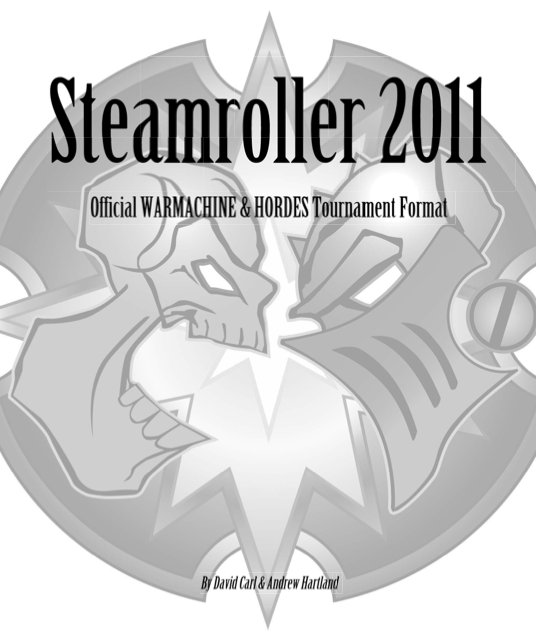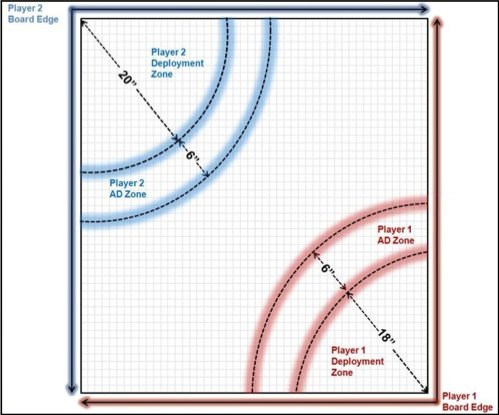Warmachine/Hordes: Steamroller 2011

Now that we’ve had the rules for Steamroller 2011 in-hand for the last few weeks, I thought it’d be appropriate to discuss the format. Overall, it maintains the flavor and feel of previous Steamroller formats, there are a number of important changes that are worth mentioning.
The rules for running a tournament remain as tight as ever. Steamroller 2011 keeps the old Swiss pairing system, rules for match and turn timing, but makes some slight modifications to the rules for extended turn length based on the army size. Instead of a 5-minute extension regardless of game size, each standard game size gets its own extended time limit. While I don’t think the change was entirely necessary, it is yet another example of how Privateer is dedicated to make the tightest tournament system possible.
 |
| Fear no more… |
Another welcome change is that most of the scoring conditions now begin triggering at the end of the second player’s second turn, granting some breathing room over SR2010’s rules, which often lead to jamming or denial strategies that were designed to largely stop the opposing player’s army from advancing, making some of the scenarios a lot easier for a limited group of warcasters and warlocks to win.
The standard rules of deployment have changed slightly. While staggered deployment remains, the difference in deployment zone size is now only a 2″ deficit over the previous 4″. This isn’t a huge change, but it does make the advantage of going second due to scenario initiative and extra deployment area less clear. Many of the scenario rules themselves have been streamlined. Flags and objectives always follow the same rules without any difference in how they work between scenarios, save some specific modifications for the Grind scenario. There have been slight changes to the terrain rules as well, limiting blocking terrain from being placed inside scoring areas.
The scenario rules are where the big changes happen. There was a lot of work done here to make Steamroller events less favorable towards a very specific group of warcasters and warlocks. The first example is that there are four different types of scenarios: Center, Dual, Distant, and Radial. Center scenarios are pretty much what they sound like: scenarios that direct the action towards the center of the board. Dual scenarios focus also direct action towards the center of the board, but instead require players to work on controlling two objectives or scoring zones. Distant scenarios require that the each player strike deep into their opponent’s lines if they wish to score a scenario victory. Radial scenarios, which are largely the most radical change, force players to deploy in opposite corners of the board, fighting to control or contest objectives and zones all over the board. The nicest part about the categorizing of scenarios is that a single scenario type is not supposed to be repeated, making scenario meta-gaming even more difficult to do.
Overrun is the first of the Center scenarios, and remains largely unmolested, save that the scoring zone has a bit more real estate and that scoring does not begin until the second player’s second turn. Kill Box is exactly the same as it was in the past, providing players with a simple caster-kill game. Close Quarters also is the same, save the scoring timing rules. Gaining Ground is a new scenario for Steamroller. There are three 18″x6″ scoring zones that are three inches apart. Players score one point for controlling the zone in the middle and two points for controlling the zone on their opponent’s side of the board. This is a nice high-risk, high-reward scenario that will give aggressive players a big advantage and punish gun line armies that sit on their haunches and just blast away.
Process of Elimination is first Dual scenario and another returning scenario that has been slightly revised. The scoring zones are 2″ smaller and the new timing rules apply. Revelation is a flag scenario with a flag placed on the center line and 16″ from one of the board edges. Once a player scores on the flag, another flag is placed 16″ from the other table edge. The first to three points wins. I’m a fan of this scenario. While winning by scenario will often be pretty hard, players will be forced to play aggressively and commit their forces to the center battle line. Incursion is the third of the Dual scenarios and also remains largely the same, save that the distance between flags has been increased to 12″. While I’m not often a fan of random scenario elements, I like the way this one plays. Players have to think on their feet and commit their forces smartly. Outflank, Outfight, Outlast also is pretty similar to its previous incarnation, but also features larger scoring areas than before (noticing a theme?).
The final and most radical category is Radial. Deploying in corners is a nice change of pace, but not without some strange rules interactions, like with Ambush, which is limited to two board edges. In addition to their odd deployment rules, the mechanics for scoring are quite interesting as well. All of the require that players both control a flag and contest a scoring area. In my play-testing experience, these scenarios were actually really fun, and presented a variety of strategies for victory.
The first Radial scenario is Command and Control, which places a large controlling zone in the center of the board with flags 8″ from the northern, southern, eastern, and western board edges. Players must control the zone in the center of the board while contesting any one of the flags with their warcaster. While this scenario was obviously designed with the intent of limiting warcasters like Epic Deneghra or Gorten from shutting players out of the scoring area, it none-the-less requires good strategy and placement to achieve success. Diversion places contesting areas on the edge each player’s deployment zone with scoring flags to protect to the player’s left. In order to score, the contesting area must be contested and the flag to your right controlled. This scenario is a tricky one, as scenario victories here require big risk and sacrifice, but in the Diversion games I’ve played, I’ve still found it very possible to win via point scoring. Demolition is the Radial version of Grind with a few subtle changes. Players have to be move the objectives into scoring areas they control, which are located along a diagonal axis on the board. I haven’t had a chance to play this scenario yet, but it looks like a good one. The last scenario is Sacrifice. There is a large scoring area centered 16″ forward and in from one corner and flag 16″ forward and in from the opposite. Players must have a model in base contact with the flag in addition to controlling the scoring area in order to score a point. The kicker here is that models in base-to-base with the flag after a point is scored suffer a POW 20 magic damage roll, hence the scenario title. While this is another scenario I haven’t played yet, it looks fun, but I worry about some of the freeze-/push-out methods that were popular in earlier versions of Steamroller.
After the scenario rules, there are a plethora of rules for tournament variation, including different mechanics for timed turns that can make for shorter turns or even incorporate chess clocks. Also included are different rules for painting requirements, army list variants, round variants, victory variants, etc. These variations create lots of guidelines for tournament organizers to customize the event to meet their needs or community preferences.
Overall, the document looks like a big step forward. David Carl (aka D.C./Dacarnix) and Andrew Hartland (aka Hacksaw76) have produced a pretty fantastic document for organized play. Every year, the Steamroller rules feel a little tighter than year previous, and SR2011 looks like an even bigger improvement than usual.
What are your experiences/thoughts on the new SR2011 document?







